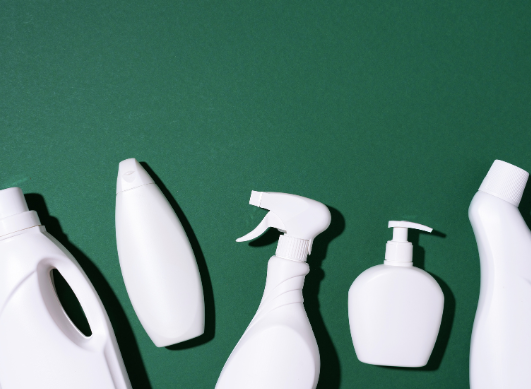How to get rid of Endocrine Disruptors hiding in your household?
Published May 4, 2024 • By Somya Pokharna
Hidden within our everyday surroundings are chemicals known as endocrine disruptors, which can interfere with our hormonal systems and are capable of causing serious health issues such as cancer, birth defects, and other developmental disorders, affecting any part of the body that our hormones regulate.
The widespread presence of these chemicals in our household items is a rising cause for concern.
So, what exactly are endocrine disruptors? In which household items can they be found? How can you eliminate them and make your environment safer?
Dive into this article to detox your daily life!

What are endocrine disruptors? How do they work?
Endocrine disruptors are chemicals that interfere with the endocrine system, which is responsible for regulating the body's hormones. Hormones act as messengers, telling various parts of the body how to function. When endocrine disruptors enter the body, they can mimic or block natural hormones, upsetting normal hormonal balance.
Here’s how endocrine disruptors can work:
- Mimicking natural hormones: Some disruptors are structurally similar to natural hormones and can bind to hormone receptors. For example, chemicals like bisphenol A (BPA) can mimic estrogen. When they bind to estrogen receptors, they produce effects similar to or stronger than the natural hormone, potentially leading to overstimulation of certain bodily processes.
- Blocking hormones: Endocrine disruptors can also block natural hormones from binding to their receptors, thus preventing the hormones from exerting their effects. This can lead to underactivity of certain bodily systems that depend on those hormones.
- Altering hormone levels: These chemicals can influence the synthesis, conversion, or breakdown of hormones, altering the natural levels of hormones in the body. For instance, some pesticides can inhibit enzymes that are crucial for hormone production.
Endocrine disruptors can enter the human body through ingestion, inhalation, or skin absorption, leading to various health effects depending on the nature of the disruptor and the level of exposure.
Which products contain endocrine disruptors?
Some common types of endocrine disruptors and the wide array of typical household items in which they can be found are as follows:
Bisphenol A (BPA)
BPA is found in plastic containers, water bottles, and the linings of food and beverage cans. BPA can leach into food and drinks, especially when containers made with it are heated.
Phthalates
Phthalates are found in vinyl flooring, plastic wrap, and personal care products like shampoos, soaps, lotions, and fragrances. They render plastics more flexible and are also used as solvents in cosmetics.
Parabens
Parabens are found in cosmetics, moisturizers, hair care products like shampoos and conditioners, and pharmaceuticals as preservatives.
Triclosan
Triclosan is found in antibacterial soaps, detergents, toothpastes, and some cosmetics. It is added for its antibacterial properties but can disrupt thyroid hormone-associated gene expression.
Perfluorinated chemicals (PFCs)
PFCs are found in non-stick cookware, stain-resistant carpets and fabrics, and water-repellent clothing. PFCs are used to make surfaces resistant to stains, water, and grease.
Polybrominated diphenyl ethers (PBDEs)
PBDEs are found in flame retardants used in a variety of products, including furniture foams, electronics, and carpets. PBDEs can leach out into the environment and accumulate in human tissue.
Dioxins
Dioxins are found in meat, dairy, fish, and shellfish. They are by-products of combustion and certain industrial processes, and are highly persistent in the environment and accumulate in the food chain.
How to eliminate endocrine disruptors from your home?
Reducing the presence of these substances in the home involves being mindful of the composition of household items and choosing alternatives that are free from these harmful chemicals.
Be cautious with plastics, cookware, and food storage
Look for products labeled as BPA-free. However, be cautious as some BPA-free plastics may contain other harmful chemicals.
Replace non-stick cookware with stainless steel, ceramic, or cast-iron alternatives.
Do not microwave food in plastic containers or use plastic wrap to cover food while heating, as this can cause chemicals to leach into food. Even for storage, use glass or stainless-steel food containers which do not leach chemicals instead of plastic containers.
Many canned food linings also contain BPA or similar substances. Go for fresh or frozen foods instead.
Select natural and organic personal care products
Read labels on cosmetics, lotions, and shampoos to avoid products containing phthalates and parabens. Look for products marketed as "paraben-free" and "phthalate-free." When possible, use organic personal care products that are less likely to contain hormone-disrupting chemicals.
Use natural cleaning products
Look for green-certified, eco-friendly cleaning products that don't contain harsh chemicals. Basic ingredients like vinegar, baking soda, and lemon can also be used to create natural yet effective cleaning solutions.
Improve indoor air quality
Ventilate your home by regularly opening windows and using exhaust fans to reduce the concentration of airborne chemicals from indoor sources. An air purifier with a HEPA filter can be used to capture particulate matter, including dust that may contain endocrine disruptors.
Choose furniture and household items wisely
Opt for furniture that is free from flame retardant chemicals. Check labels and ask retailers about the chemical treatments used on furniture. Where possible, choose natural fiber rugs and textiles like wool, cotton, or jute which are less likely to be treated with harmful chemicals.
Be mindful of children’s products
Buy safer toys made of natural materials or those explicitly marked as free from BPA, phthalates, and PVC. Avoid baby products made with harmful flame retardants or plasticizers. For bottles, go for glass or BPA-free plastic.
Key Takeaways
Endocrine disruptors are chemicals that can interfere with the body’s hormone systems, leading to significant health concerns. They work by mimicking natural hormones, blocking their actions, or altering hormonal levels, thus disrupting bodily functions dependent on hormonal regulation. Common sources include everyday items such as plastic containers, cosmetics, non-stick cookware, and flame retardants in furniture.
Reducing exposure in the home requires vigilance and informed choices, such as opting for BPA-free products, using natural cleaning solutions, and selecting personal care products without harmful additives. By making these adjustments, you can decrease the potential health risks associated with these disruptive chemicals, safeguarding your and your family’s health in the process.
Was this article helpful to you?
Give it a "Like" and share your thoughts and questions with the community in the comments below!
Take care!
Sources:
9 Ways to Avoid Hormone-Disrupting Chemicals — Natural Resources Defense Council
Avoiding endocrine disruptors in furniture, carpets, clothes and other fabrics — CHEM Trust
Common EDCs and Where They Are Found — Endocrine Society
Endocrine disruptors — European Chemicals Agency
Endocrine Disruptors and Your Health fact sheet — National Institute of Environmental Health Sciences
Endocrine disruptors in household products — HealthCentral
Endocrine-Disrupting Chemicals (EDCs) — Endocrine Society
Endocrine-Disrupting Chemicals — Endocrine Society
EWG’s guide to endocrine disruptors — Environmental Working Group
How to avoid endocrine disruptors in cleaning products — CHEM Trust
Identification of combinations of endocrine disrupting chemicals in household chemical products that require mixture toxicity testing — Lee, Inhye, and Kyunghee Ji. Ecotoxicology and environmental safety vol. 240 (2022): 113677.
Making a Healthier Home — NIH News in Health
Endocrine Disruptors — National Institute of Environmental Health Sciences
Overview of Endocrine Disruption — US Environmental Protection Agency
The Room-by-Room Home Detox Guide — Green America
What are endocrine disruptors? — Environmental Working Group
What You Can Do About EDCs — Endocrine Society
Comments
You will also like

Spoon theory: What is it and how can it help people living with chronic illness?
Apr 13, 2022 • 7 comments

What is the psychological impact of chronic pain? Carenity members share their experience!
May 27, 2021 • 8 comments

 Facebook
Facebook Twitter
Twitter
